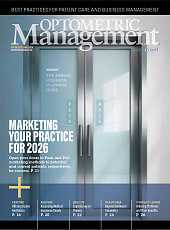A 12-year-old Asian female was referred for myopia control consultation. Her records showed consistently increasing myopia and options were discussed with the patient’s parents. They opted for orthokeratology (ortho-k) contact lenses, which were ordered empirically and dispensed for wear.
Exam Findings
At the one-month ortho-k follow-up, the patient’s entering unaided visual acuities were 20/20 OD and OS with no complaints. Axial topographies are shown in Figures 1 and 2 for OD and OS, respectively. The middle photo reflected the baseline topography, the left photo was the one-month follow up, and the right photo was the subtractive map.


Discussion
Ortho-k causes myopic defocus, which has been shown by numerous clinical studies slowed the progression of myopia.1-3 The ideal shape of the cornea after ortho-k treatment is a centrally flattened zone. However, the center of the treatment zone is often not aligned with the center of the pupil for ortho-k wearers.4 There are several studies that show controversial conclusions on how decentration of ortho-K lenses affect axial length. Sun and colleagues found that ortho-k lens decentration did not significantly cause axial length changes in children with > 12 months of treatment.4There are many other factors still being studied to investigate optimal myopia control including magnitude of defocus, retinal eccentricity, and percentage of surface area.5
Conclusion
While the effects of ortho-k decentration on axial length are still being investigated, the parents of this patient opted to remake the lenses for a more centralized treatment zone. Future studies on the optimal defocus of ortho-k lenses will likely affect contact lens designs and fitting practices of eyecare professionals.
References
- Cho P, Cheung SW, Edwards M. The longitudinal orthokeratology research in children (LORIC) in Hong Kong: a pilot study on refractive changes and myopic control. Curr Eye Res. 2005 Jan;30(1):71-80. doi: 10.1080/02713680590907256
- Walline JJ, Jones LA, Sinnott LT. Corneal reshaping and myopia progression. Br J Ophthalmol. 2009 Sep;93(9):1181-1185. doi: 10.1136/bjo.2008.151365
- Kakita T, Hiraoka T, Oshika T. Influence of overnight orthokeratology on axial elongation in childhood myopia. Invest Opthalmol Visual Sci. 2011 Apr 6;52(5):2170-2174. doi: 10.1167/iovs.10-5485
- Sun L, Li ZX, Chen Y, He ZQ, Song HX.The effect of orthokeratology treatment zone decentration on myopia progression. BMC Ophthalmol. 2022 Feb 15;22(1):76. Doi: 10.1186/s12886-022-02310-4
- Erdinest N, London N, Lavy I, Berkow D, Landau D, Morad Y, Levinger N. Peripheral Defocus and Myopia Management: A Mini-Review. Korean J Ophthalmol. 2023 Feb;37(1):70-81. doi: 10.3341/kjo.2022.0125



